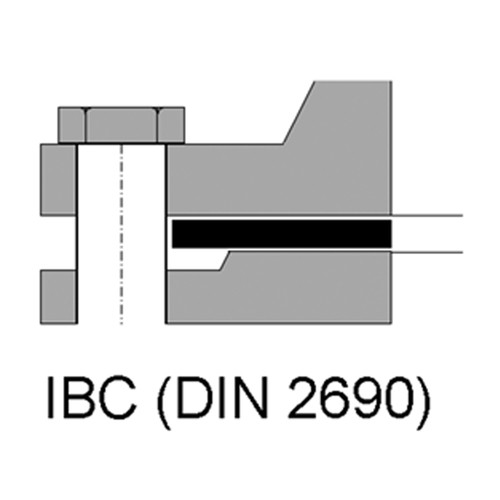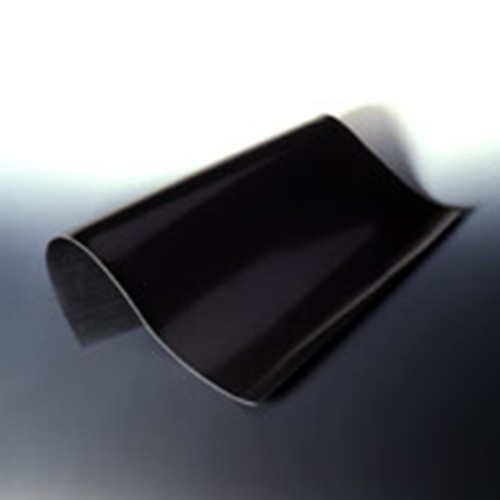High-Performance FPM Flat Seals
Application area
Very well suited for use in:
Mineral oils, fats and waxes, motor oils and fuels, aliphatic and aromatic hydrocarbons, amines, hydraulic fluids, essential oils, and in high-temperature applications.
Should not be used in:
Concentrated acids (e.g. nitric or formic acid), concentrated oxidizing media (e.g. peracetic acid).
Product specification
Outstanding temperature resistance
Very good resistance to ozone, oxygen, aging, and weather
Excellent resistance in mineral oils and fats
Low permeability to gas
Very good resistance in nonpolar media
Shows significant swelling in polar solvents and ketones
Technical specification
Material: FPM (fluorocarbon rubber)
Color: black
Crosslinking: peroxidic
Shore hardness A: 75° ±5 (test plate) (DIN 53504)
Temperature range: -10 to +200 °C
Density: approx. 2.00 g/cm3 (DIN 53505)
Tensile strength: approx. 9 MPa
Elongation at break: approx. 200 %
Tear propagation resistance: approx. 5 N/mm2
General Information
Flat seals are usually stamped as rings. For more complicated geometries, the rings are frequently cut by means of plotter or water jet. Rings are defined by the dimensions of the internal and external diameter as well as by the total thickness of the ring but often also by nominal diameter and pressure stage according to DIN 2690, 2691 (or 2692). For the purpose of harmonizing standards, these former flat seal standards are summarized in the EU standard DIN.
EN 1514-1. Still, the following sub-descriptions serve the purpose of illustrating the individual shapes: former DIN 2690: now EN 1514-1 Form IBC for smooth flanges; former DIN 2691: now EN 1514-1 Form TG for flanges with groove and tongue.
Advantages compared with other sealing elements:
symmetrical cross section, simple compact design, easy installation, wide selection of materials, grooving not required
Most common application: Flange sealing against liquid or gaseous media; static or quasistatic applications only.
Further applications: Housing and cover sealings.
Method of operation: The flat seal is axially pressed when mounting. The axial press force has to be greater than the sum of all radially acting forces to eliminate the risk of leakage. Cross-sectional leakage (the leakage diffused through the sealing material) is minimized by the selection of the right material. An optimal grouting of the flat seal prevents surface leakage, i.e. leakage occurring between flange and seal.
Materials for special requirements:
These flat seals are especially suited for use in processes that must comply with TA-Luft requirements.
Form IBC for smooth flanges: NW 10 to 200, PN 2.5 to 63
Form TG for flanges with groove and tongue: NW 10 to 200, PN 10 to 160
Manufacturing: according to the latest standards, with an optimal tool park, for quick and flexible handling, the traceability of materials is guaranteed, all parts go through a quality check before packaging.
| Item | Image | Design1 |
Innen-Ø mm
|
Außen-Ø mm
|
Höhe mm
|
NW mm
|
PN bar
|
Einheit Stück
|
Price Euro* | Buy |
|---|
Item
|
Image
|
Design1
|
Innen-Ø mm
|
Außen-Ø mm
|
Höhe mm
|
NW mm
|
PN bar
|
Einheit Stück
|
Price Euro* |
Buy
|
|---|---|---|---|---|---|---|---|---|---|---|
| 409088 |
|
IBC | 18 | 39 | 2 | 10 | 6 | 10 | 159.00 | |
| 409089 |
|
IBC | 18 | 39 | 2 | 10 | 6 | 20 | 270.00 | |
| 409090 |
|
IBC | 18 | 46 | 2 | 10 | 40 | 10 | 159.00 | |
| 409091 |
|
IBC | 18 | 46 | 2 | 10 | 40 | 20 | 270.00 | |
| 409092 |
|
IBC | 18 | 56 | 2 | 10 | 63 | 10 | 159.00 | |
| 409093 |
|
IBC | 18 | 56 | 2 | 10 | 63 | 20 | 270.00 | |
| 409094 |
|
IBC | 22 | 44 | 2 | 15 | 6 | 10 | 153.00 | |
| 409095 |
|
IBC | 22 | 44 | 2 | 15 | 6 | 20 | 256.00 | |
| 409096 |
|
IBC | 22 | 51 | 2 | 15 | 40 | 10 | 153.00 | |
| 409097 |
|
IBC | 22 | 51 | 2 | 15 | 40 | 20 | 256.00 | |
| 409098 |
|
IBC | 21 | 61 | 2 | 15 | 63 | 10 | 153.00 | |
| 409099 |
|
IBC | 21 | 61 | 2 | 15 | 63 | 20 | 256.00 | |
| 409100 |
|
IBC | 27 | 54 | 2 | 20 | 6 | 5 | 131.00 | |
| 409101 |
|
IBC | 27 | 54 | 2 | 20 | 6 | 10 | 229.00 | |
| 409102 |
|
IBC | 27 | 61 | 2 | 20 | 40 | 5 | 131.00 | |
| 409103 |
|
IBC | 27 | 61 | 2 | 20 | 40 | 10 | 229.00 | |
| 409104 |
|
IBC | 25 | 72 | 2 | 20 | 63 | 5 | 131.00 | |
| 409105 |
|
IBC | 25 | 72 | 2 | 20 | 63 | 10 | 229.00 | |
| 409106 |
|
IBC | 34 | 64 | 2 | 25 | 6 | 5 | 173.00 | |
| 409107 |
|
IBC | 34 | 64 | 2 | 25 | 6 | 10 | 302.00 | |
| 409108 |
|
IBC | 34 | 71 | 2 | 25 | 40 | 5 | 173.00 | |
| 409109 |
|
IBC | 34 | 71 | 2 | 25 | 40 | 10 | 302.00 | |
| 409110 |
|
IBC | 30 | 82 | 2 | 25 | 63 | 5 | 173.00 | |
| 409111 |
|
IBC | 30 | 82 | 2 | 25 | 63 | 10 | 302.00 | |
| 409112 |
|
IBC | 43 | 76 | 2 | 32 | 6 | 5 | 224.00 |






























